What Is Abstract Art? Definition & Examples of Famous Abstract Paintings
In this article, we will cover an abstract art definition — the use of elements like color, line, shape and form in a non-realistic way. We will also look at examples with explanations of paintings by Pablo Picasso, Jackson Pollock, Salvador Dalí, Piet Mondrian, Henry Moore, Mark Rothko, Wassily Kandinsky and Georgia O’Keeffe. That way, you can get a better sense of what the meaning of abstract art is, and you can also become familiar with famous examples of abstract art.
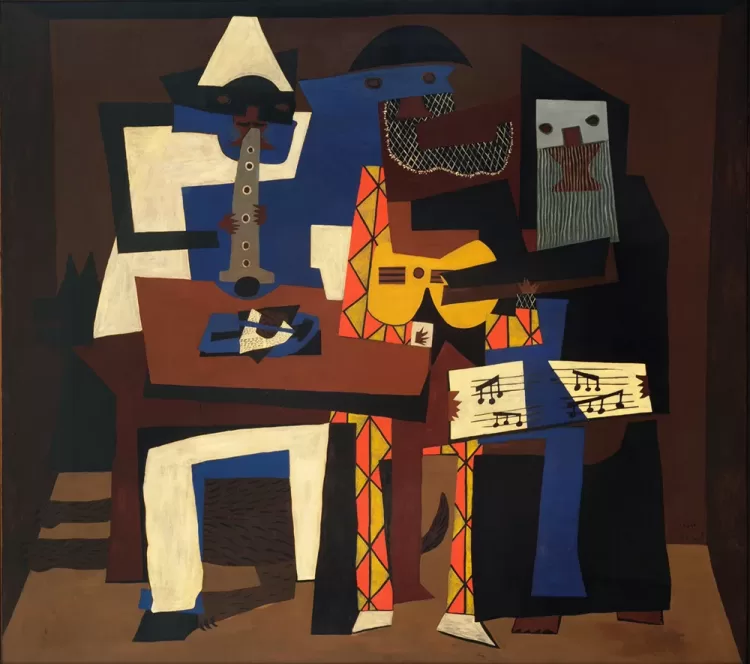
Pablo Picasso’s Three Musicians (1921) [Courtesy of MoMA]
Abstract art deals primarily with ideas in its subject matter. In its form, it is usually removed from realism and does not try to represent the physical world in a common sense way. Many people find abstract art inaccessible because it often has no recognizable forms in it — as other types of visual arts do.
The organizing principle of composition becomes the primary way through which meaning is made in abstract art, dealing with the impact of things like balance, direction, contrast, and symmetry.
So, what is abstract art?
-
- Abstract art is characterized by a reduction to the elements of art; for example, color, line, shape and form. Abstract artists make use of these elements, sometimes in a very simplified way.
Examples of Famous Abstract Paintings
To get an idea of how abstract art works in the real world, let’s explain 8 abstract art examples by famous abstract artists:
1. Pablo Picasso’s Girl with Mandolin (1910)
The Cubists, Picasso and Braque, abstracted their ideas by painting very ordinary things but representing multiple thoughts simultaneously, transparently superimposed over one-another. They seemed to want to point out that the visual experience of something was never a simple, one-angled shot, but is made up of our ability to move in space, and have three-dimensional vision as a result of the positioning of our eyes. So, although they may have painted a still-life, the purpose of these modern paintings was the idea of how we perceive space, form and our environment.
Braque, Gris, Léger and especially Picasso could have produced accomplished paintings playing by the rules of perspective, but Cubism totally rejected this method. Gris described Cubism as “simply a new way of representing the world.” It still aimed to paint a convincing representation of reality. Yet unlike art that had gone before, Cubist paintings were more than happy to admit to being flat objects. — Tate
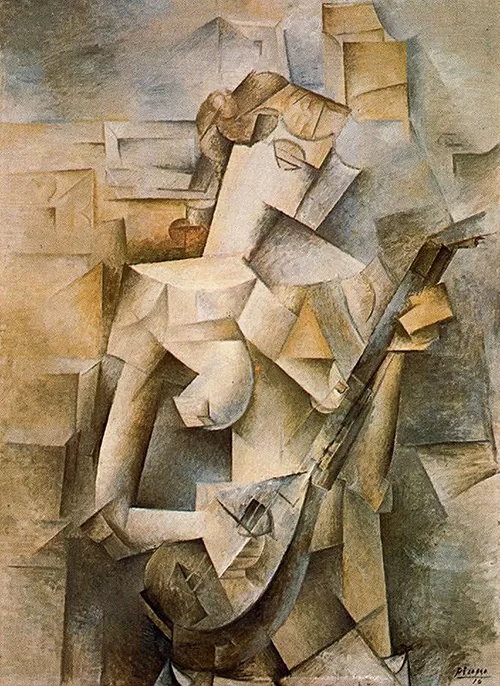
Pablo Picasso’s Girl with Mandolin (1910) [Public Domain]
Among the abstract art examples we’ll be looking at throughout this article, Picasso’s 1910 effort Girl with Mandolin is one of his most famous paintings and least “abstract,” as we think of it. You can clearly tell that this is exactly what the title suggests.
But see how he breaks out a simple view into so many possibilities all existing side-by-side on a flat plane. He also abstracts away detail, so that the underlying ideas about geometry can take center stage.
This shows us a major power of abstract art: to take away unnecessary information. In the case of the example above, Picasso filled that void of realistic detail with his new approach to perspective. This proved an important lesson for cubism, and you’ll see that color details are often dramatically reduced. Later on, we’ll see how just restricting information can be enough to create daring art.
Guernica, Picasso’s most famous artwork, combines cubism and surrealism. This painting shows the suffering and horrors of war.
2. Wassily Kandinsky’s Composition VI (1913)
Wassily Kandinsky is an abstract artist whose mission was to illustrate profound spiritual experiences using forms that brought us out of the everyday world. To do this, he helped pioneer many techniques in abstract art while also borrowing the bright color palette of the Fauvists (painters that experimented with unrealistic color choices). Like Hilma af Klint, perhaps the first abstract artist, Kandinsky was inspired by his esoteric and occult beliefs. His style allows the viewer to see the mystical and universal themes in the world or in purely abstract compositions.
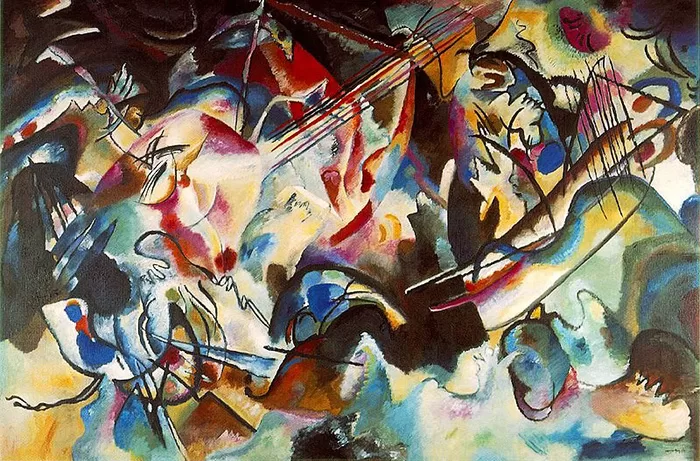
Wassily Kandinsky’s Composition VI (1913) [Public Domain]
Music played an important role in the development of Kandinsky’s abstract paintings. The famous Viennese composer Arnold Schönberg was one influence. Schönberg abandoned tonal and harmonic conventions in his compositions the same way that Kandinsky rejected the figure or recognizable object in favor of shapes, lines, and discordant colors in his work. He deployed color, line, shape, and texture to create a rhythmic visual experience that evoked an emotional response. Not surprisingly, Kandinsky gave many of his paintings musical titles, such as Composition or Improvisation. — Denver Art Museum
The above abstract painting, like so many of Kandinsky’s pieces, was inspired by music. Music, especially the kind without lyrics, was a great teacher to the artist, as it was able to make people feel with the purely abstract toolkit of notes and harmony.
He uses his ideas about the spiritual power of shapes and color to inform how his paintings will affect the viewer. Consider the stormy, dark colors and aggressive shapes in the top left corner. Compare that to the calmer, gentler bottom right. Though nothing is really pictured here, we are able to feel the difference.
3. Piet Mondrian's Tableau I (1921)
Mondrian reduced his paintings to the three primary colors (red, blue and yellow), black, white and gray. He also systematically removed curved lines from his paintings, resulting in the colorful grids so well-known over the past century. His subject matter? Well, he was trying to find a universal set of visual terms that could be recognized and interpreted by all people, regardless of their cultural background.
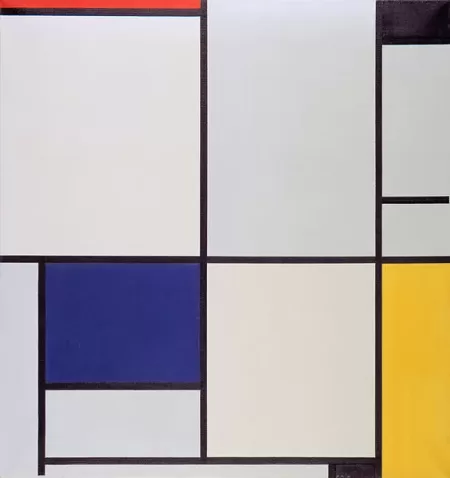
Piet Mondrian’s Tableau I (1921) [Courtesy of Wikimedia]
Let’s look at his 1921 painting Tableau I (pictured above) to see how he unites all these elements in a single canvas.
The first thing you’ll note about the above painting is how everything is separated by bold black lines. These give the entire composition structure. In this example of abstract art, there is a great deal of order and stability provided by the boxes, and a rhythm even begins to emerge. Meanwhile, the primary colors grab our attention, because they are so bold and clear.
So, with only the simplest tools, Mondrian can balance and structure his composition while also keeping our eye interested.
4. Georgia O’Keeffe’s Red Canna (1923)
Georgia O’Keeffe wrote, “A flower is relatively small. Everyone has many associations with a flower—the idea of flowers. You put out your hand to touch the flower—lean forward to smell it—maybe touch it with your lips almost without thinking—or give it to someone to please them. Still—in a way—nobody sees a flower—really—it is so small—we haven’t time—and to see takes time like to have a friend takes time. If I could paint the flower exactly as I see it no one would see what I see because I would paint it small like the flower is small. So I said to myself—I’ll paint what I see—what the flower is to me but I’ll paint it big and they will be surprised into taking time to look at it—”. — CHRISTIE’S
Inspired by the landscape of rural New Mexico, the skyscrapers of New York City, the gentle folds of flower petals, and the exquisite details of skulls — Georgia O’Keeffe simplified shapes down to their essence, allowing the inherent beauty of line and color to create a powerful style that went beyond the bounds of realism. One of the ways she did this was to zoom into her subject, eliminating any context for its shape (as we’ll see below). She also experimented broadly with surreal images, including paintings of enormous skulls floating above desert landscapes.
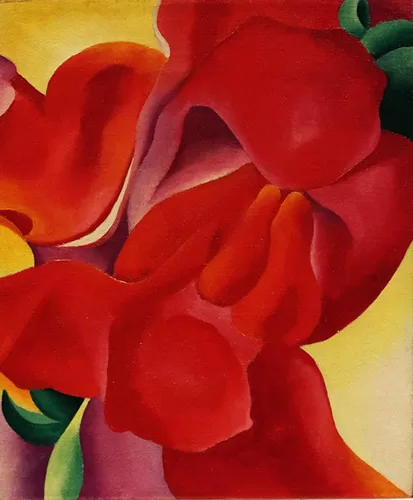
Georgia O’Keeffe’s Red Canna (1923) [Public Domain]
In the abstract painting above, O’Keeffe zooms up into the details of a red canna flower. By blowing up the image of a flower to such proportions, she is able to lovingly detail the colors and curves in an abstract way.
Her use of color itself is fairly abstract, too, as she forgoes creating textures, preferring gradients to show shading. This pushes it further away from realism and toward the abstract, but always anchored in the reality of the flower itself.
5. Henry Moore’s Four Studies of Miners at the Coalface (1942)
At the other end of the scale is Henry Moore, who, although best known for his monumental bronze sculptures, tried to capture the essence of human form by removing detail in his unique paintings. A quick review of his drawings and early work will prove that he does not end up with such monumentally simple forms because he is unable to observe or reproduce the human form realistically. But he, like Mondrian, looks at what minimum amount of information is needed in the artwork in order for its intent to still be understood by a viewer.
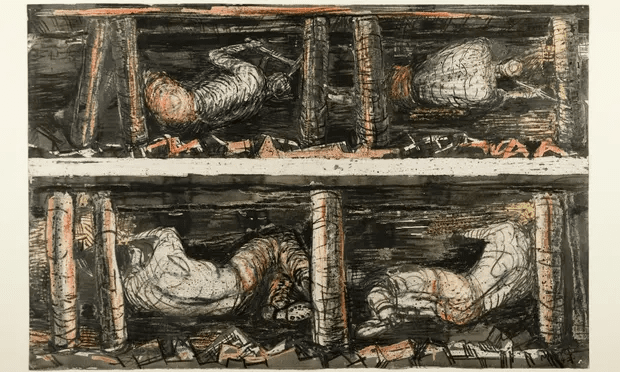
Henry Moore’s Four Studies of Miners at the Coalface (1942) [Courtesy of Henry Moore Foundation]
The studies above show just how effective a reduction in detail can be. Though we can’t make out much beyond the shapes of bodies in the dark, it is enough to have an emotional reaction to the images — especially with the context of the title.
The cramped, almost coffin-like conditions of coal mining are haunting, all the more so as we struggle to see in the dark with them, thanks to Moore’s style.
It’s worth noting that this approach to reducing information to the bare minimum is somewhat reminiscent of what we saw in Picasso. It reminds us of the first steps in our abstract art definition, which focuses on a reduction of detail to the fundamentals — but not always a total elimination of reality.
6. Jackson Pollock’s Blue Poles (1952)
There is a misconception that abstract art is about a kind of wild expressionism. But most abstract artists work with intellectual points of view, and employ as much thinking and technical skill in creating their images as the masters of the Renaissance did. Even Jackson Pollock, whose paintings seem to be the aftermath of a frenzy of paint splashing, had a gentle, considered technique of applying carefully selected colors to his giant paintings to create depth, layers, interesting relationships, patterns and conflicting focal points. He created form through an excess of detail.
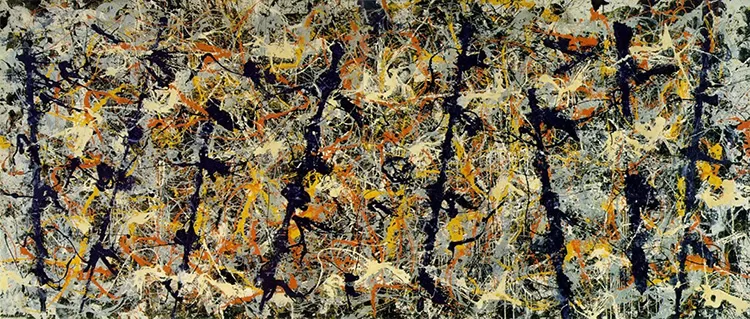
Jackson Pollock’s Blue Poles (1952) [Courtesy of Art Plastique & Appliqué]
This example of abstract art is close to what many people imagine when they think of the term. Pollock’s trademark drip technique creates a chaotic image, but that chaos begins to recede the more we look.
The thick, diagonal shots of blue create a kind of foreground, giving us something to consider. To contrast that, Pollock makes the background dominated by yellow and oranges, colors that set the blue off well. Though it seems wild at first, these careful decisions make the painting deceptively coherent.
7. Mark Rothko’s Orange, Red, Yellow (1961)
“My pictures are indeed façades (as they have been called),” he once said. “Sometimes I open one door and one window or two doors and two windows. I do this only through shrewdness. There is more power in telling little than in telling all.” That mystery and complexity have given him one of the most enduring and esteemed reputations in 20th-century art. — Artsy
Other abstract artists turn their attention to the artist’s materials themselves, looking in a focused way at how they can be used in new ways. Rothko painted large amorphous fields of color made up of many layers of transparent layers of color, looking to express basic human emotions. And, doing so, he draws the attention of the viewer to the mood evoked, the textures arrived at, and the fact that shapes conform very self-consciously to the edges of the canvas. He makes the point that art is never objective, always lives inside a context, and can allow the creative process to bring forth new discoveries.
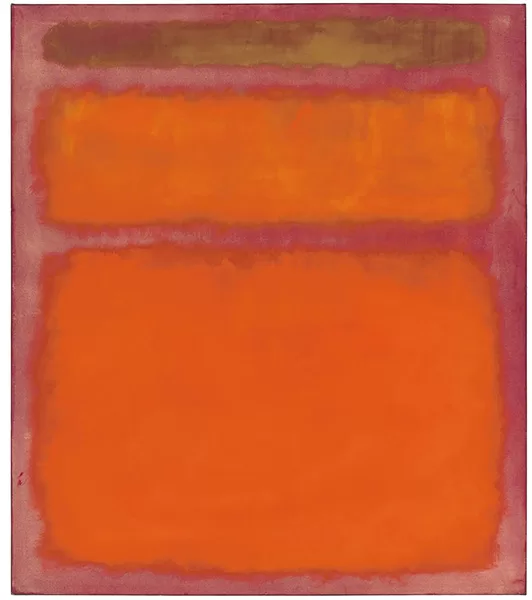
Mark Rothko’s Orange, Red, Yellow (1961) [Courtesy of The New York Times]
Though not overly complex, Rothko’s abstract art example above gives us a taste of just how much you can do with texture, color, and the most basic shapes.
Here, we are invited to explore how orange interacts with the pink field behind it. And we are able to contemplate the way the rectangles shrink as our eyes move up the canvas. We can laser in on these very fundamental features of painting because nothing else is there to distract us.
When seen in person, you will also find that Rothko creates his color fields with extreme care, allowing light to go through a dazzling array of layers on its way down to the canvas and back out towards the viewer.
8. Salvador Dalí’s The Hallucinogenic Toreador (1968-70)
Dalí’s Surrealist paintings are surely his finest work—even though his penchant for excess often led him to paint too many shocking images on a single canvas and too many canvases that seem to repeat themselves. But at his best, Dalí, a superb draftsman, could be spare and orderly. — Smithsonian Magazine
Salvador Dalí was a Surrealist artist originally from Spain. Though his paintings are extraordinarily detailed and in some ways, realistic, the things that happen in his paintings are strange, absurd, and dreamlike — in short, they are surreal. Though his work is very different from the others on this list, it is important to see how abstraction can also be related to subject matter itself. After all, Dalí uses the techniques of painting to create images that are not realistic in that they are impossible. On top of that, he borrows some compositional ideas from other abstract artists.

Salvador Dalí’s The Hallucinogenic Toreador (1968-70) [Courtesy of Wikipedia]
Dalí creates the painting above by mixing together images in ways that would never exist in the real world. And in this work, he pushes things so far to the breaking point that the work begins to act like other abstract paintings. Of course, given that he does have recognizable things in the mix, you can begin to analyze it almost like a dream.
See how rhythm and color become more important than the actual literal things he is depicting. The houseflies, for instance, aren’t really being used as houseflies. They are being borrowed by Dalí for their shape and the way they look lined up in rows.
Final Thoughts
So, abstract art, far from being a primitive modality invented by people who can’t draw, is an intellectual art movement. Abstract artists shy away from reproducing pictures of reality (photography has that covered in this day and age) in favor of working with ideas. As we see from the above abstract art examples with explanations, this movement tries to show us something new, tries to point out things we’ve missed in our common sense way of living.
This movement helped to define art in the 20th century, and it continues to make waves well into the 21st. Many still ask, “What does abstract art mean?” But hopefully with the definition and examples above, you can appreciate this rich and varied form of creating.
This article was partially written by Caroline Magget. Read the disclaimer…
PLEASE SHARE THIS:
